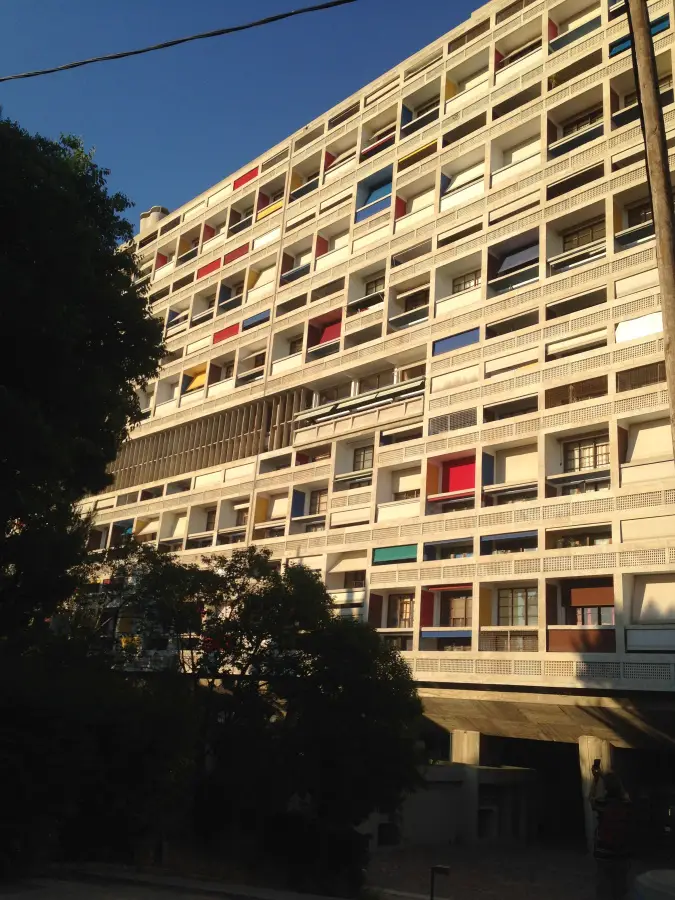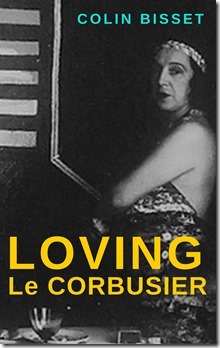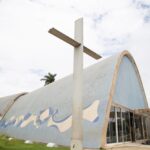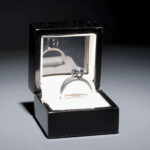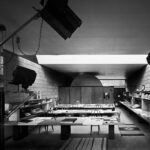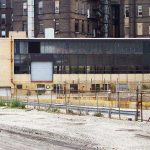Architect Le Corbusier’s early drawings 1902-1916, Modern building photo, Teatro dell’architettura Mendrisio Switzerland
Le Corbusier’s early drawings. 1902-1916
21 Sep 2020
Location: Teatro dell’architettura Mendrisio, Via Turconi 25 – 6850 Mendrisio, Switzerland
Le Corbusier’s early drawings. 1902-1916 News
Curated by Danièle Pauly
September 19, 2020 – January 24, 2021
Teatro dell’architettura Mendrisio
Exhibition promoted by
Fondazione Teatro dell’architettura
With the collaboration of the Accademia di architettura – Università della Svizzera italiana
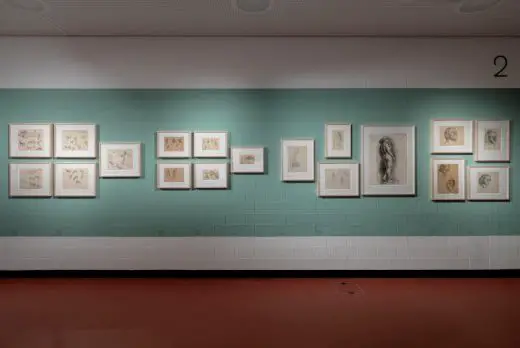
“Le Corbusier’s early drawings. 1902-1916” | © Enrico Cano, Teatro dell’architettura Mendrisio, interno, Università della Svizzera italiana | Architect: Mario Botta
From Saturday September 19, 2020 to Sunday January 24, 2021, the Teatro dell’architettura Mendrisio presents the exhibition “Le Corbusier‘s early drawings. 1902-1916″ promoted by the Fondazione Teatro dell’architettura, in partnership with the Accademia di architettura of the Università della Svizzera Italiana in Mendrisio.
Unité d’Habitation, Marseille, Southern France, celebrated work by Corb:
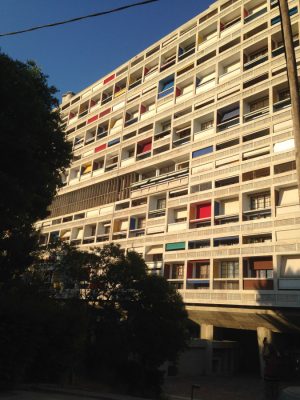
photo from Colin Bisset
This extensive review features more than eighty previously-unpublished original drawings from public and private Swiss collections, and includes numerous reproductions of drawings from the Fondation Le Corbusier in Paris. It is being held to mark publication of the first volume of the Catalogue raisonné des dessins de Le Corbusier, edited by Danièle Pauly, published by AAM-Bruxelles in coedition with the Fondation Le Corbusier and thanks to the Mendrisio’s Fondazione Teatro dell’architettura contribution.
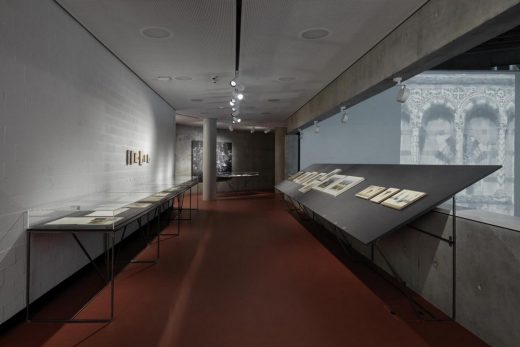
Le Corbusier’s early drawings. 1902-1916 ; image © Enrico Cano at Teatro dell’architettura Mendrisio, interno, Università della Svizzera italiana | Architect: Mario Botta
THE EXHIBITION
Curated by Danièle Pauly, this exhibition is devoted to drawings a young Le Corbusier executed between 1902 and 1916: from the year he started attending the School of Applied Arts in La Chaux-de-Fonds, his hometown, to the year before his definitive move to France and the establishment of the architectural studio in Paris.
Almost all of the drawings on display belong to private and public Swiss collections and are largely unpublished: the public will thus have for the first time the opportunity to learn about an exceptional body of rare documents. The exhibition is rounded off by a series of reproductions of original drawings and travel notebooks that Le Corbusier made during the same period.
The Teatro dell’architettura therefore welcomes the story of what determined the birth of a vocation that the young Charles-Edouard Jeanneret, the future architect Le Corbusier (1887-1965), initially thought to be that of a painter. The decisive moment in his education came when he went to study at the School of Art and Applied Arts. There, he attended watchmaking and architecture departments between 1902 and 1907, influenced by charismatic master Charles L’Eplattenier, a painter who subscribed to the ideas of John Ruskin and the Arts and Crafts movement.
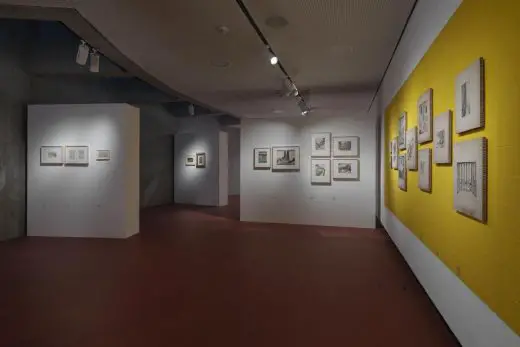
“Le Corbusier’s early drawings. 1902-1916” | picture © Enrico Cano, at the Teatro dell’architettura Mendrisio, interno, Università della Svizzera italiana | Architect: Mario Botta
Other factors that strongly impacted Le Corbusier’s advancement were his experience at Auguste Perret’s atelier in Paris between 1908 and 1909, his frequent visits to museums, encounters with avant-garde European architects at the start of the 20th century, and finally, encouraged by his mentor William Ritter, his study trips between 1907 and 1911 that culminated in a long journey to the East, an experience that deeply influenced his projects in later years..
The works selected for this exhibition show the importance Le Corbusier attributed to drawing from his early days. For the architect, drawings was a way of approaching reality, an instrument for observation. This is clearly evident in the studies of nature he made from 1902 to 1905, during his early years at school. For young Charles-Edouard Jeanneret, drawing was a tool for analysis and research, as we may see from the studies he drew at Parisian museums, and from his early architectural drawings when he was at La Chaux-de-Fonds, between 1905 and 1907.
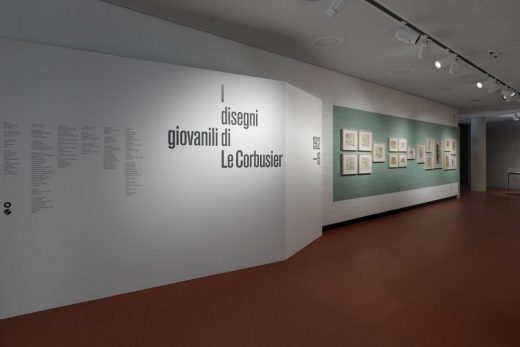
“Le Corbusier’s early drawings. 1902-1916” | photo © Enrico Cano, Teatro dell’architettura Mendrisio, interno, Università della Svizzera italiana ; Architect: Mario Botta
For Le Corbusier, sketches and drawings were also a tool to serve memory, as we may see from his many sketches in notebooks made during his travels; they were also a means of lyrical expression, for example the watercolours and gouaches of landscapes and female nudes that he painted after his return to Switzerland in 1912.
The exhibition is divided into different sections, starting with Le Corbusier’s school years characterized by meticulous pencil drawings of naturalistic subjects, small watercolors of landscapes, decorative studies and projects of handicraft objects with Art Nouveau motifs, and then moving on to his period of travel and stays in European capitals: a trip to Italy in 1907 dedicated to studying the Middle Ages and paintings by the “primitive” Italian school, a return to Paris in 1908-1909 where he gained professional experience at the Perret brothers’ atelier, as well as studies of Notre-Dame and from the city’s many museums. He followed this with a trip to Germany in 1910, when he stayed at Peter Behrens’ Berlin atelier, and then went on a long tour of German cities, before his great initiatory journey to the East in 1911.
The final section of the exhibition showcases his return to La Chaux-de-Fonds (1912-1916), a period when Le Corbusier taught, embarked on his work as an architect, and devoted himself to painting ad drawing a series of landscapes, portraits, family scenes, female nudes and still lifes, foreshadowing the main subjects of the second stage of his output, in which works of purist inspiration continued to prevail.
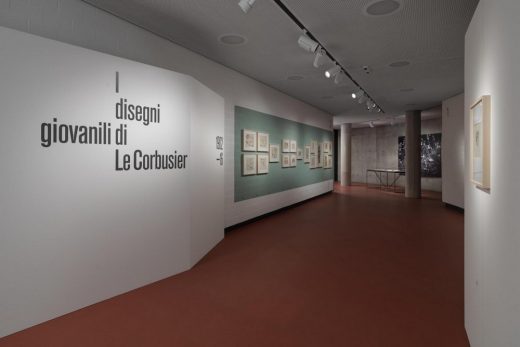
“Le Corbusier’s early drawings. 1902-1916” | photograph © Enrico Cano – Teatro dell’architettura Mendrisio, interno, Università della Svizzera italiana | Architect: Mario Botta
LE CORBUSIER 1902-1916
Le Corbusier, the pseudonym adopted by Charles-Edouard Jeanneret-Gris (1887-1965), was one of the greates architects and urban planners in human history, as well as a painter and sculptor. The son of Georges-Eduard Jeanneret-Gris, an engraver and watch enameller, and Maria Carlotta Amelia Jeanneret-Perret, a musician, he trained at the School of Applied Art in La Chaux-de-Fonds, as an engraver of watch cases.
During his training, he attended drawing and decoration courses, along with an advanced course in interior decoration. Initially keen on pursuing a career as a painter, on the advice of Charles L’Eplattenier, young Jeanneret embarked on a course in architecture that would open the path to his profession.
In 1907, on concluding his studies, he began a journey in Europe. He travelled to Italy, to discover ancient architecture: to Austria, to discover the works of the Wiener Wekstätte and meet the Viennese Secession milieu; to France, where he worked as a draughtsman at the Perret brothers’ atelier in Paris, and to Germany, where he met personalities such as William Ritter, Theodor Fischer, Heinrich Tessenow, Hermann Muthesius and Bruno Paul, working for a spell at Peter Behrens’ practice in Berlin.
Villa Savoie, France:
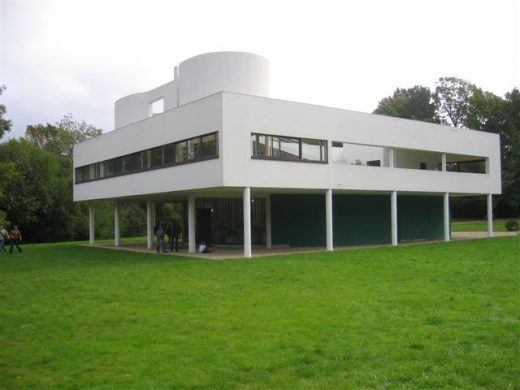
photo © Isabelle Lomholt
In 1911, with Augusto Klipstein, then a student of art history, he embarked on a long trip to the East, stopping in Prague, Vienna, Budapest, Belgrade, Bucharest, Tarnovo, Gabrovo, Kasanlik, Istanbul, Mount Atos and Athens On his way back to Switzerland, Le Corbusier once again stopped over in Italy, this time to visit Naples, Pmpeii, Rome, Florence, the Certosa di Galluzzo and Pisa. During his Eastern Journey he made hundreds of drawings and sketches, filling entire notebooks with them as well as making annotations.
Later, in 1912, Le Corbusier settled in La Chaux-de-Fonds, where he began teaching Decorative Composition and Architectural Composition in the New Section of the School of Art, and began practicing as an architect at the Ateliers d’Art Réunis. That same year, he won a commission to build a house for his parents at Pouillerel.
Between 1915 and 1916, he stayed in the Landeron, where William Ritter settled, and made several trips to Paris where he designed his Dom-Ino model prefabricated reinforced concrete houses with Max Du Bois. He later met Tony Garnier in Lyon and a few months later, in January 1917, he settled in Paris and opened his first architecture practice..
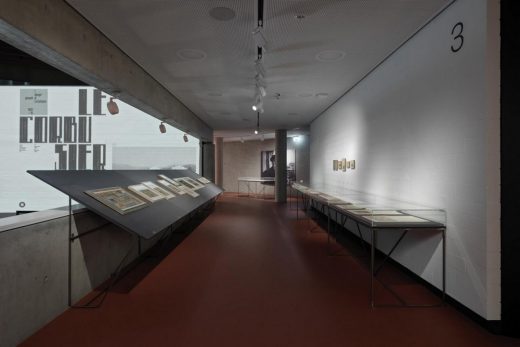
“Le Corbusier’s early drawings. 1902-1916” ; picture © Enrico Cano Italy – Teatro dell’architettura Mendrisio, interno, Università della Svizzera italiana | Architect: Mario Botta
DANIÈLE PAULY
Danièle Pauly is an art historian who obtained her doctorate at the Université des Sciences Humaines de Strasbourg. She is an honorary professor in the Ecole nationale supérieure d’Architecture at Paris-val-de-Seine. Over the years, he research has focused on the work of Le Corbusier, theatre set design and Mexican architecture.
After her early publications, including Ronchamp, lecture d’une architecture (Pu de Strasbourg, 1980), curating exhibitions such as Le Corbusier et la Méditerranée (Centre de la Vieille Charité, Marseille, 1987) and the artistic works section of L’aventure Le Corbusier (Centre Pompidou, Paris, 1987), in recent years Danièle Pauly has devoted herself to researching the Swiss architect’s graphic works through exhibitions Le Corbusier, le dessin comme outil (Nancy, 2006-2007), Le Corbusier. Le jeu du dessin (Antibes-Münster, 2015-2016) and Le Corbusier.
The Paths to Creation (Seoul, 2016-2017), along with publication of Le Corbusier. Albums d’Afrique du Nord in 2013, of Ce labeur secret, Le Corbusier et le dessin in 2015 and in 2018 Le Corbusier. Drawing as Process, published by Yale University Press.
She is the author of the Catalogue raisonné des dessins de Le Corbusier, of which Volume I was published at the end of 2019.
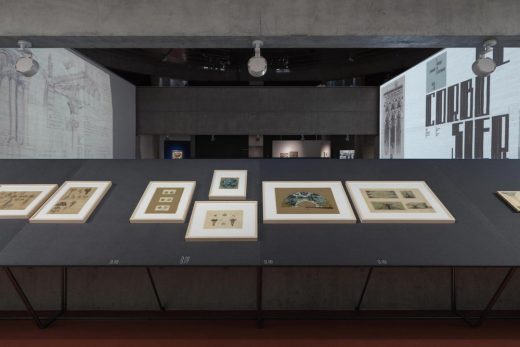
“Le Corbusier’s early drawings. 1902-1916” ; image © Enrico Cano, Italy – Teatro dell’architettura Mendrisio, interno, Università della Svizzera italiana | Architect: Mario Botta
THE CATALOGUE ON DISPLAY
“Catalogue raisonné des dessins de Le Corbusier”
Volume I, 1902-1916
edited by Danièle Pauly
Between October 1902 and May 1965, Le Corbusier made several thousand drawings and sketches. About 5000 of these are housed at the Fondation Le Corbusier, the rest are in public and private collections. Starting in 2019, working in partnership with the Fondation Le Corbusier AAM Editions (Paris-Brussels) began an ambitious project to publish a four- volume catalogue raisonné of the architect’s drawings.
The first volume, which is on sale at the exhibition after publication in December 2019, is dedicated to Le Corbusier’s education and travel (1902-1916), until he definitively moved to Paris in early 1917.
AAM Editions Bruxelles / Fondation Le Corbusier
supported by:
Centre National du Livre, Parigi
Fondazione Teatro dell’architettura, Mendrisio
32 x 24 cm, 304 pages, cartonboard, 968 ill., b/w and colour, french language edition
Price at exhibition 50 CHF/Euro
Chapel of Notre Dame du Haut in Ronchamp, France:
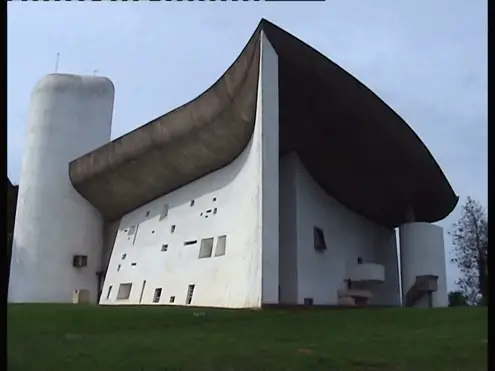
photograph from Colin Bisset
LIVING LE CORBUSIER
The Accademia of architettura of the Università della Svizzera Italiana, in partnership with MDFF-Milano Design Film Festival, is promoting the “Living Le Corbusier” programme, a selection of films made between 1966 and 2018 by French, Italian, Swiss architect, which can be viewed from 19 September 2020 to 24 January 2021 in the Gallery on the second floor of the Teatro dell’architettura Mendrisio.
THE TEATRO DELL’ARCHITETTURA A MENDRISIO
The Teatro dell’architettura Mendrisio, built on the Campus of the Academy of Architecture – Università della Svizzera Italiana, was designed by arch. Mario Botta, promoted and realized thanks to the joint work of the Università della Svizzera italiana and the Fondazione Teatro dell’architettura, in order to offer a privileged dialogue space for the cultural debate on architecture, the city, the landscape.
Alongside the teaching and research activities carried out within the Academy of Architecture, this initiative aims to strengthen the educational offer with exhibitions, seminars and different activities to give visibility to the new transdisciplinary interests that increasingly intervene in the design process and redefine the social role of architecture.
The Teatro dell’architettura also serves as a platform for exchange with other institutions for which contemporary culture is the field of interest.
MUSEI D’ARTE DEL MENDRISIOTTO
In 2020 the Teatro dell’architettura Mendrisio, together with the Vincenzo Vela Museum in Ligornetto, the Pinacoteca Giovanni Züst in Rancate, the m.a.x. museum in Chiasso and the Museo d’arte Mendrisio, have activated the Network Musei d’Arte del Mendrisiotto (MAM) with the aim of strengthening visibility, promoting knowledge and enhancing the presence of the institutions themselves, underlining the diversity, richness and complementarity of their cultural offerings (painting, sculpture, architecture, design, graphics and photography) both at regional and national level and internationally.
In order to encourage the public to move around the territory and visit the museums of Mendrisiotto, on the occasion of the promotion of the network and starting from September 2020.
INFORMATION
“Le Corbusier’s early drawings. 1902-1916”
September 19, 2020 – January 24, 2021
Curated by Danièle Pauly
Exhibition promoted by the Fondazione Teatro dell’architettura, in partnership with the Accademia di architettura – Università della Svizzera italiana.
Teatro dell’architettura Mendrisio
Via Turconi 25 – 6850 Mendrisio, Switzerland
Open days:
sunday 04.10.2020, 10 am- 6 pm
sunday 01.11.2020, 2 pm- 6 pm
sunday 06.12.2020, 10 am -6 pm
sunday 03.01.2021, 10 am – 6 pm
sunday 24.01.2021, 10 am – 6 pm
Reserved required at info.tam@usi.ch
For accreditation/exhibition press kit:
Servizio Comunicazione istituzionale USI
E-mail: media.tam@usi.ch
In Italy: ddl studio | T +39 02 8905.2365
Alessandra de Antonellis | E-mail: alessandra.deantonellis@ddlstudio.net | T +39 339 3637.388
Ilaria Bolognesi | E-mail: ilaria.bolognesi@ddlstudio.net | T +39 339 1287.840
Calendar and Opening Hours:
“Le Corbusier’s Early Drawings. 1902-1916” Exhibition.
September 19, 2020 – January 24, 2021
· tuesday / wednesday/ thursday / friday: 2-6 pm
· saturday / sunday: 10 am – 6 pm
· information on special openings and closures: http://www.arc.usi.ch/tam
Contact and info:
Tel.: +41 58 666 5867 – E-mail: info.tam@usi.ch
Tickets for the “Le Corbusier’s Early Drawings. 1902-1916” Exhibition
· Full price: CHF/Euro 10.-
· Reduced: CHF/Euro 7.- (Students wirth card, FAI Italia, FAI Swiss, OTIA, AVS/AI, groups)
· Free entrance: Students, USI-SUPSI collaboratorators and teachers, Friends of the Academy of Architecture, anyone under the age of 18, and all pupils at school in the Canton of Ticino.
· Reduction of 2 CHF/Euro for MAM card holders
LIVING LE CORBUSIER
September 19, 2020 – January 24, 2021
Curated by Silvia Robertazzi and Marco Della Torre
Programme organized by the Accademia di architettura – USI, in partnership with Milano Design Film Festival
Teatro dell’architettura Mendrisio
Via Turconi 25
6850 Mendrisio, Switzerland
Calendar and Opening Hours
“Living Le Corbusier” programme
September 19, 2020 – January 24, 2021
· tuesday / wednesday / thursday / friday: 2 – 6 pm
· saturday / sunday: 10 am – 6 pm
· information on special openings and closures: http://www.arc.usi.ch/tam
· Programme of screenings on the website http://www.arc.usi.ch/en/news/detail/30144
· Free entrance
Contact and info
Tel.: +41 58 666 5867 – E-mail: info.tam@usi.ch
Le Corbusier Buildings
Le Corbusier – highlights below:
Villa Le Lac, Corseaux, Switzerland by Jan Theuninck, acrylic on canvas, 70 x 100 cm, 2017
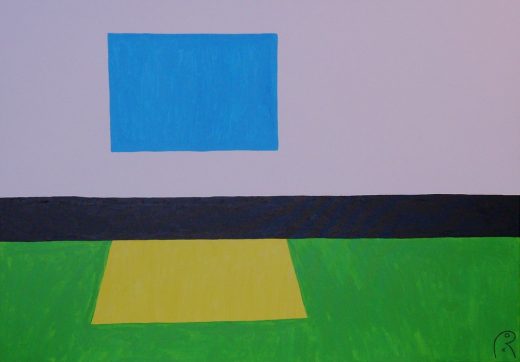
image courtesy of Jan Theuninck
Loving Le Corbusier
A new novel ‘Loving Le Corbusier’, tells the story of Yvonne, the wife of architect Le Corbusier.
Yvonne, the architect’s wife:
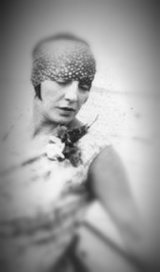
photograph © Fondation Le Corbusier
The architect’s grave – designed by himself – in the south of France:
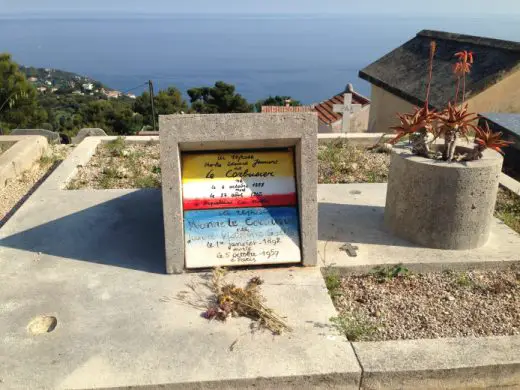
photo from author Colin Bisset
Cité de Refuge, 12 Rue Cantagrel, 75013 Paris, France
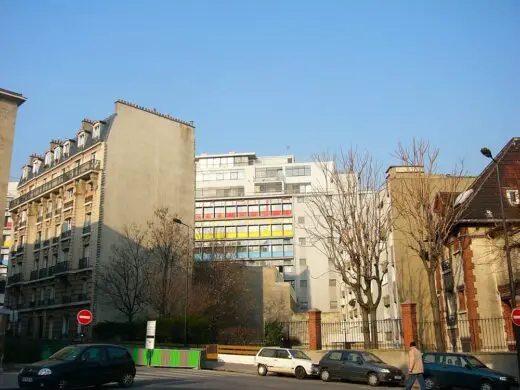
photo by Rory Hyde
Cité de Refuge Building in Paris
Corb Tapestry at Sydney Opera House, New South Wales, Australia
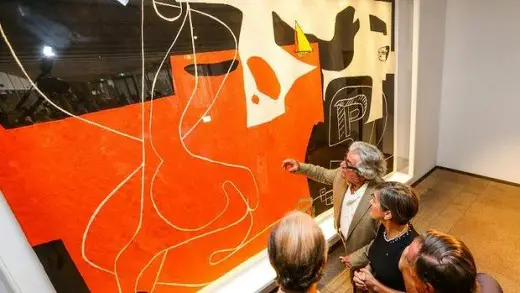
photo from www.smh.com.au
Sydney Opera House
, Paris, France – added 12 Jun 2011
Date built: 1925
Design: with Pierre Jeanneret
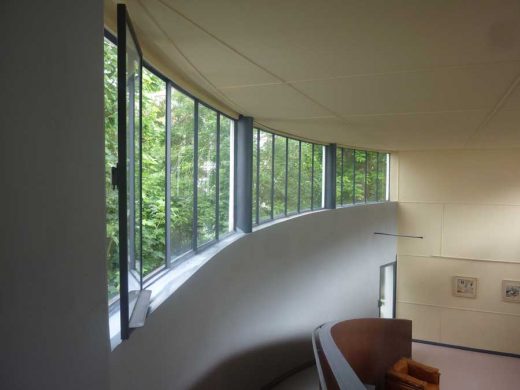
photograph © Karavan
Villa La Roche
Villa Savoie, Poissy, north west of Paris, France
Date built: 1929
Villa Savoie – key Modern French building
Villa Savoye : photos of this famous Le Corbusier house as a ruin.
Le Corbusier Show : The Interior of the Cabanon
Le Corbusier Exhibition : RIBA, London
Unité d’Habitation, Berlin
German Unité d’Habitation Berlin Le Corbusier building
American Le Corbusier building – UN Building New York
Location: 35 rue de Sèvres, Paris, France
Architecture Practice Information
Former architect studio based in Paris, France – world-famous Modernist architect
Corb had his architect studio at 35 rue de Sèvres from 1922 with his cousin Pierre Jeanneret.
Paris Architects : Parisian Architecture Studios
Modern Architecture
Buildings / photos for the Le Corbusier Paris Architecture – French Modernist Architect page welcome
Website: Fondation Le Corbusier, Paris

